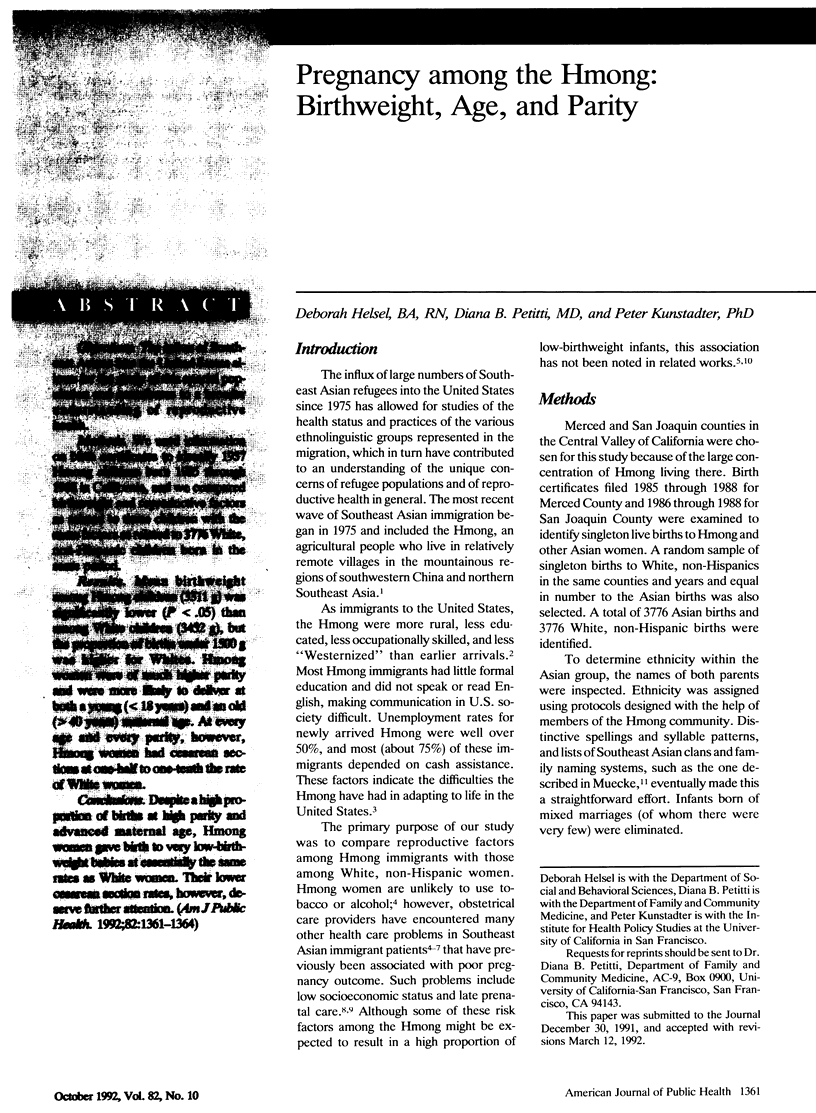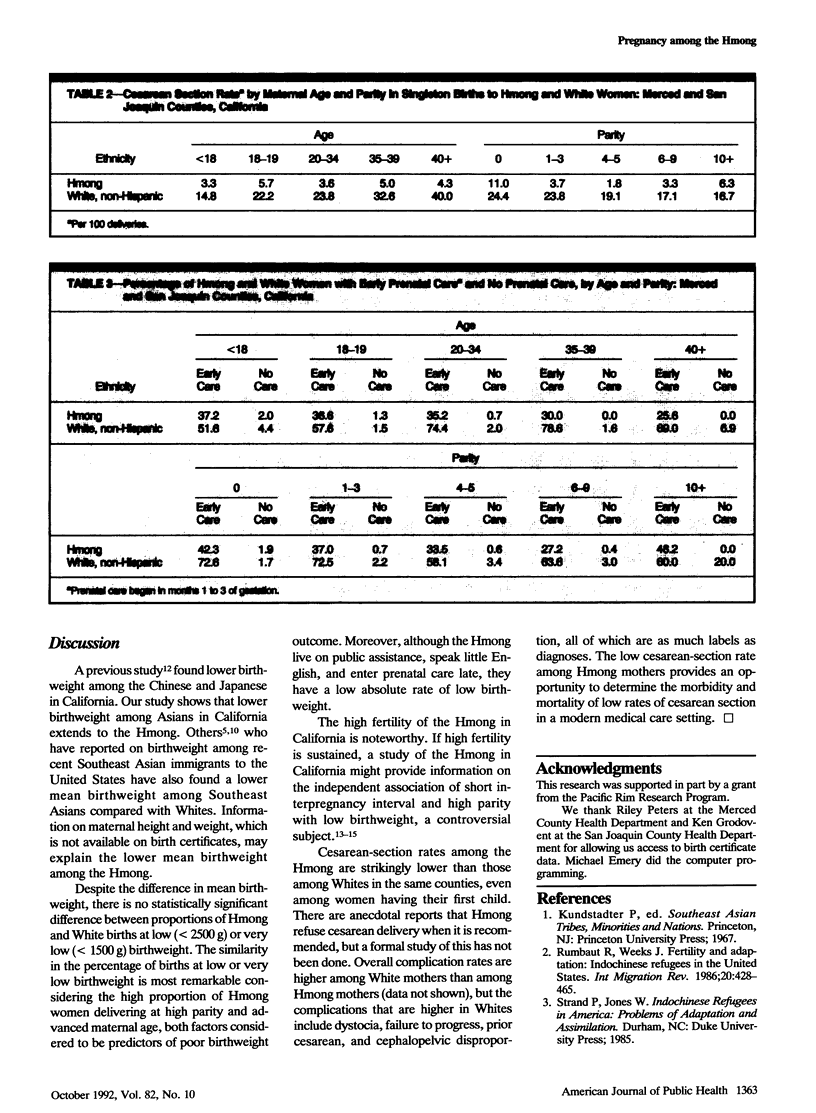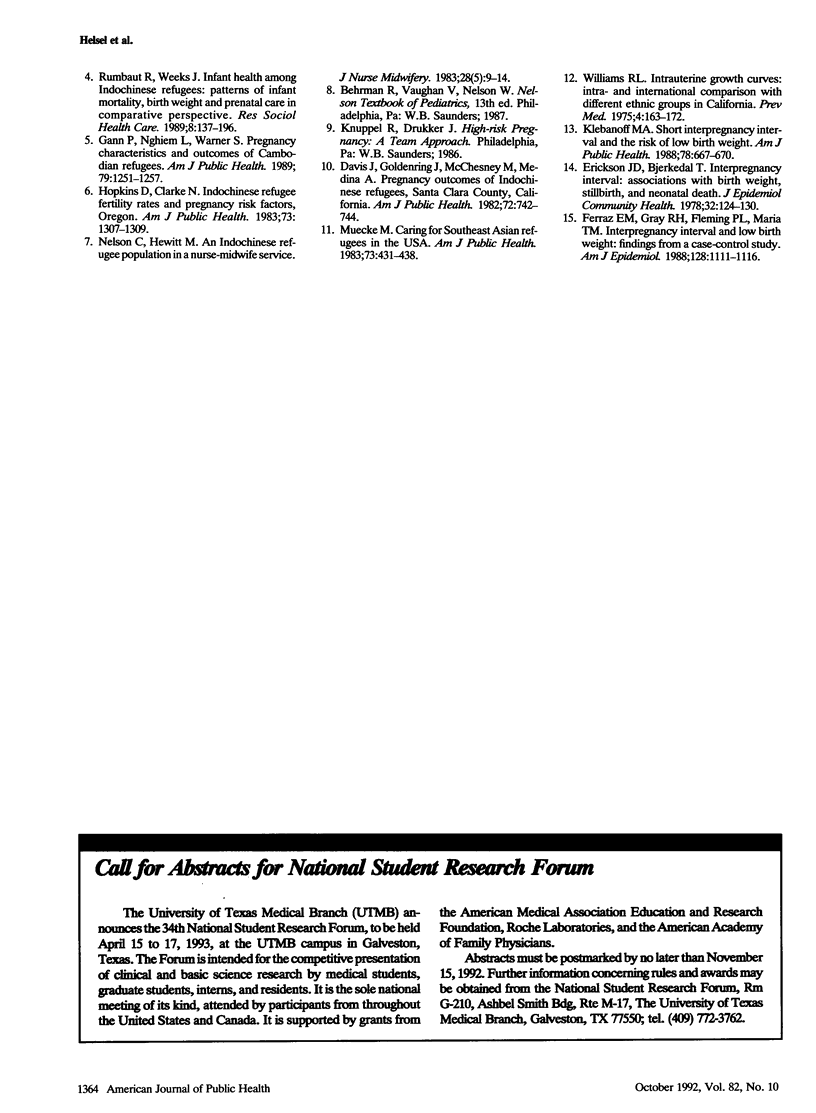Abstract
OBJECTIVES. The influx of Southeast Asians into the United States allows for the study of this special population and contributes to a broader understanding of reproductive health. METHODS. We used information on birth certificates to identify 1937 Hmong children born 1985 through 1988 in California, and we compared birthweight and reproductive factors as related to these children with the same factors as related to 3776 White, non-Hispanic children born in the same period. RESULTS. Mean birthweight among Hmong children (3311 g) was significantly lower (P less than .05) than among White children (3452 g), but the proportion of births under 1500 g was higher for Whites. Hmong women were of much higher parity and were more likely to deliver at both a young (less than 18 years) and an old (greater than 40 years) maternal age. At every age and every parity, however, Hmong women had cesarean sections at one-half to one-tenth the rate of White women. CONCLUSIONS. Despite a high proportion of births at high parity and advanced maternal age, Hmong women gave birth to very low-birthweight babies at essentially the same rates as White women. Their lower cesarean section rates, however, deserve further attention.
Full text
PDF



Selected References
These references are in PubMed. This may not be the complete list of references from this article.
- Davis J. M., Goldenring J., McChesney M., Medina A. Pregnancy outcomes of Indochinese refugees, Santa Clara County, California. Am J Public Health. 1982 Jul;72(7):742–744. doi: 10.2105/ajph.72.7.742. [DOI] [PMC free article] [PubMed] [Google Scholar]
- Erickson J. D., Bjerkedal T. Interpregnancy interval. Association with birth weight, stillbirth, and neonatal death. J Epidemiol Community Health. 1978 Jun;32(2):124–130. doi: 10.1136/jech.32.2.124. [DOI] [PMC free article] [PubMed] [Google Scholar]
- Ferraz E. M., Gray R. H., Fleming P. L., Maia T. M. Interpregnancy interval and low birth weight: findings from a case-control study. Am J Epidemiol. 1988 Nov;128(5):1111–1116. doi: 10.1093/oxfordjournals.aje.a115053. [DOI] [PubMed] [Google Scholar]
- Gann P., Nghiem L., Warner S. Pregnancy characteristics and outcomes of Cambodian refugees. Am J Public Health. 1989 Sep;79(9):1251–1257. doi: 10.2105/ajph.79.9.1251. [DOI] [PMC free article] [PubMed] [Google Scholar]
- Hopkins D. D., Clarke N. G. Indochinese refugee fertility rates and pregnancy risk factors, Oregon. Am J Public Health. 1983 Nov;73(11):1307–1309. doi: 10.2105/ajph.73.11.1307. [DOI] [PMC free article] [PubMed] [Google Scholar]
- Klebanoff M. A. Short interpregnancy interval and the risk of low birthweight. Am J Public Health. 1988 Jun;78(6):667–670. doi: 10.2105/ajph.78.6.667. [DOI] [PMC free article] [PubMed] [Google Scholar]
- Muecke M. A. Caring for Southeast Asian refugee patients in the USA. Am J Public Health. 1983 Apr;73(4):431–438. doi: 10.2105/ajph.73.4.431. [DOI] [PMC free article] [PubMed] [Google Scholar]
- Nelson C. C., Hewitt M. A. An Indochinese refugee population in a nurse-midwife service. J Nurse Midwifery. 1983 Sep-Oct;28(5):9–14. doi: 10.1016/0091-2182(83)90132-5. [DOI] [PubMed] [Google Scholar]
- Rumbaut R. G., Weeks J. R. Fertility and adaptation: Indochinese refugees in the United States. Int Migr Rev. 1986 Summer;20(2):428–466. [PubMed] [Google Scholar]
- Williams R. L. Intrauterine growth curves: intra- and international comparisons with different ethnic groups in California. Prev Med. 1975 Jun;4(2):163–172. doi: 10.1016/0091-7435(75)90081-x. [DOI] [PubMed] [Google Scholar]


